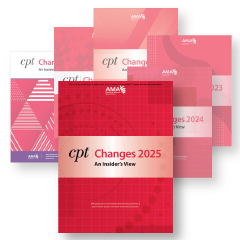by Find-A-Code™
Mar 7th, 2024
Every quarter the American Medical Association (AMA) releases an updated version of their Common Procedural Terminology (CPT) code set. If you are a medical coder or biller, you know just how prominent the CPT code set is. But how is it maintained and updated? Who determines what gets added, what gets dropped, and so forth?
Updating and maintaining the CPT code set is a long process that is an ongoing part of code maintenance by the AMA. The AMA goes to great lengths to make sure that the code set is continuously analyzed and evaluated on an ongoing basis so that only changes that actually improve the set and account for emergenging and changing technology are implemented.
The CPT Editorial Panel
Maintaining and updating the CPT code set and their associated rules and guidelines is the responsibility of the AMA's CPT Editorial Panel. According to the AMA website, at the time of publication, the panel consists medical professionals as well as other organizations. They state:
|
... 12 of its 21 members appointed by the national medical specialty societies. In addition to the specialty seats, the Panel includes a seat for the Panel chair, vice chair, two seats for members of the CPT Health Care Professionals Advisory Committee, as well as representatives from the following organizations:
|
It should also be noted that the Centers for Medicare & Medicaid Services (CMS) also have two non-voting resprenstatives which are appointed to the CPT Editorial Panel. The intent of including various stakeholders allows for a more broad perspective on coding.
The Update Process
The AMA follows a quarterly cycle for updating the CPT code set. The first step is proposal and submission. Individuals and other interested particles may review and comment on submitted proposals for revisions, deletions, and additions. The AMA gathers all this information in preparation for the next step.
Following proposal submission is panel review. The CPT Editorial Panel meets a few times a year to go through each and every proposal, analyzing it against established metrics that include:
- medical necessity
- utilization frequency
- service or procedure uniqueness
- coding accuracy
In terms of uniqueness, panel members discuss whether a procedure relating to a proposed new code is distinct enough from a similar procedure or service that already has a code within the set. If there is not enough uniqueness requiring a new code, the proposal may not be adopted.
Categorization, Dissemination, And Implementation
All the accepted proposals move on to the categorization phase. CPT codes are categorized accordingly:
- Category I – Represent procedures and services that are frequently performed in a healthcare setting. They make up the bulk of the entire code set.
- Category II – Represent supplemental tracking codes which can be used for performance measurement. These codes are typically released on a quarterly basis for easier implementation.
- Category III – Represent services and procedures that are for emerging technologies, services, and procedures. These are all services and procedures that are still under evaluation for efficacy and utilization. All Category III codes are considered to be temporary.
Category III codes are ultimately deleted over time. Those procedures and services that continue to be utilized could be given new Category I codes.
The final step in the process is to disseminate and implement the new code set. Dissemination involves publishing the changes in a timely manner so that healthcare providers, coders, and billers have time to get familiar with them. Official implementation for the majority of category I codes takes place on January 1 the following year.
Though it can sometimes feel like the AMA updates its CPT code set randomly, nothing could be further from the truth. With the publishing of each update, the AMA ushers in the start of a new cycle in anticipation of further updates.


 Quick, Current, Complete - www.findacode.com
Quick, Current, Complete - www.findacode.com